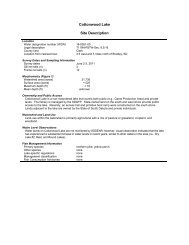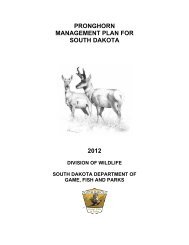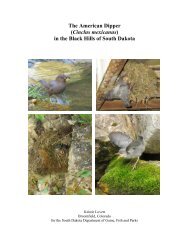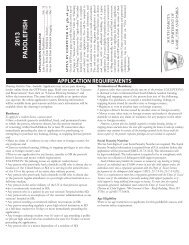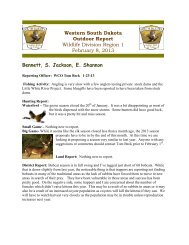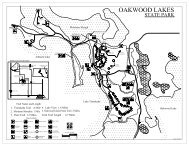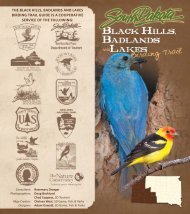pdf version - South Dakota Department of Game, Fish and Parks
pdf version - South Dakota Department of Game, Fish and Parks
pdf version - South Dakota Department of Game, Fish and Parks
You also want an ePaper? Increase the reach of your titles
YUMPU automatically turns print PDFs into web optimized ePapers that Google loves.
Mountain Sucker<br />
Catostomus platyrhynchus<br />
Quick key characteristics: The mountain sucker is found in cold- <strong>and</strong><br />
cool-water habitats. It has small, dull-colored scales <strong>and</strong> s<strong>of</strong>t fi ns with short<br />
bases. Its downward-facing mouth is wider than long <strong>and</strong> may exceed head<br />
width, jaws have scraping edges <strong>of</strong> cartilage inside lips, lower lips are wide,<br />
<strong>and</strong> there is a distinct notch where the upper <strong>and</strong> lower lips join. Its blunt,<br />
rounded snout over-hangs the mouth, <strong>and</strong> its body is tubular in shape.<br />
Similar species in <strong>South</strong> <strong>Dakota</strong>: redhorses, other suckers<br />
Identifi cation: The combination <strong>of</strong> (1) small scales, (2) a notch between upper<br />
<strong>and</strong> lower lips, <strong>and</strong> (3) cartilaginous scraping edges on jaws distinguishes the<br />
mountain sucker from similar fi shes in <strong>South</strong> <strong>Dakota</strong>.<br />
Range: The mountain sucker is native to the Middle <strong>and</strong> Northern Rocky<br />
mountains <strong>and</strong> mountains <strong>of</strong> the Great Basin <strong>and</strong> Pacifi c Northwest. It is<br />
restricted to the Black Hills in <strong>South</strong> <strong>Dakota</strong>, where it primarily occupies<br />
streams, but may also inhabit impoundments.<br />
Items <strong>of</strong> interest:<br />
• Feeds on algae <strong>and</strong> small invertebrates scraped from rocks<br />
• Breeding individuals have an orange or red lateral stripe <strong>and</strong> tubercles<br />
on lower fi ns (most prominent in males)<br />
• Suitable prey for trout<br />
• Rarely exceeds 6 in<br />
30






